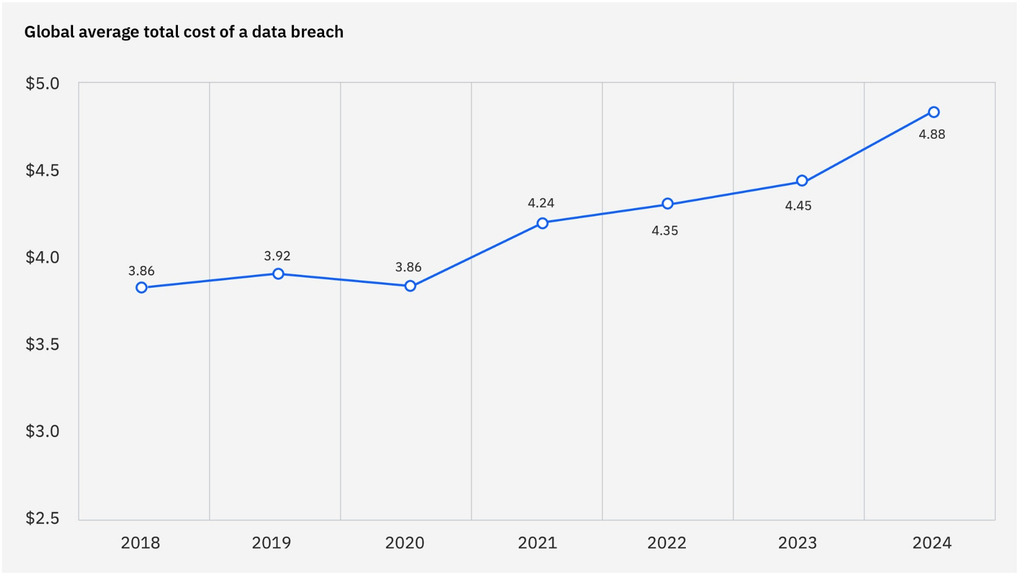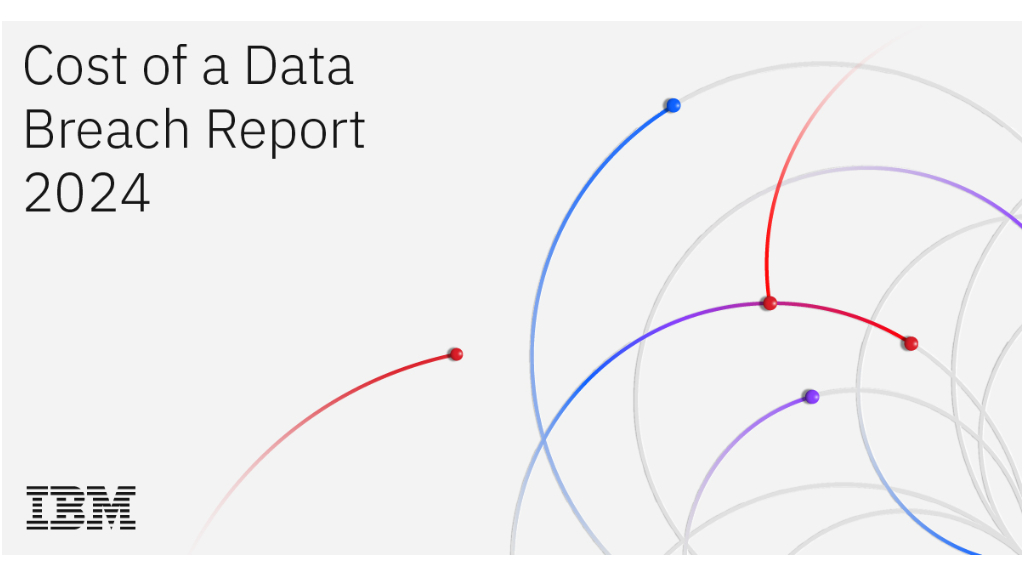IBM이 2024 데이터 유출 비용 연구 보고서(2024 Cost of a Data Breach Report)를 발표했다. 보고서에 따르면 2024년 전세계 데이터 유출 사고 한건 당 평균 비용이 488만 달러(한화 약 67억 6,100만원)에 달한다.
▲IBM '2024 데이터 유출 비용 연구 보고서'(사진=IBM)
전 세계 604개 기업 대상 보고서 발표
국내 기업 평균 비용 48억 3,300만원
AI 보안 도입 기업, 평균 98일 더 빨리 탐지
IBM이 2024 데이터 유출 비용 연구 보고서(2024 Cost of a Data Breach Report)를 발표했다. 보고서에 따르면 2024년 전세계 데이터 유출 사고 한건 당 평균 비용이 488만 달러(한화 약 67억 6,100만원)에 달한다.
국내 기업 평균 데이터 유출 비용은 올해 48억 3,300만원으로, 한국 기업이 본 조사에 포함된 지난 7년 간 중 사상 최고치를 기록했다.
응답자 중 70%는 데이터 유출로 인해 상당한 또는 매우 심각한 업무 중단을 겪었다고 말했다. 평균 유출 비용은 전년 대비 10% 증가해 팬데믹 이후 가장 큰 폭으로 상승했다.
평균 유출 비용이 가장 큰 산업은 전문 서비스(법무, 회계, 컨설팅 등)으로 약 73억원, 금융(72억원), 제조 산업(62억 8,000만원) 순이다.
보고서에 따르면, 전년 대비 올해 비용 상승의 주요 원인으로 데이터 유출로 인한 부수적인 피해가 심화되면서 비즈니스 손실과 유출 후 고객 및 제3자 대응 필요성이 꼽혔다.
조사 대상 기업의 절반 이상은 작년 심각한 수준의 인력 부족을 겪었다. 최대 574만 달러의 유출 비용이 크게 증가한 것으로 나타났다. 피해는 유출 후유증 장기화로 이어져 복구에 최소 100일 이상이 걸린 것으로 조사됐다.

▲글로벌 기준 데이터 유출 사고 한 건 당 평균 비용(사진=IBM)
한편 AI가 사이버 보안의 도구로 활용되고 있다. AI 및 자동화 솔루션을 도입한 기업이 67%로 전년 대비 10% 가까이 증가했다. 20%는 차세대 AI 보안 툴을 사용한다고 밝혔다.
조사에서는 “보안 AI와 자동화를 도입한 기업은 평균 98일 더 빨리 사고를 탐지하고 통제했다”고 전했다. 침해 비용 또한 평균 220만 달러를 절감했다. 데이터 유출 사고 발생 후 복귀까지 소요 시간은 전년 277일에서 7년 만에 최저치인 258일을 기록했다.
IBM은 “AI 기술이 위협 완화 및 대응 활동을 개선해 방어자들이 시간을 확보하는 데 도움이 될 수 있다”고 말했다.
보고서는 데이터 보안이 취약해지면서 지적 재산 도용이 증가했다고 전했다. 침해 사고의 40%는 복합적인 환경에 저장된 데이터와 관련이 있었다. 이러한 데이터 가시성 격차는 지적 재산(IP) 탈취의 급격한 증가(27%)로 이어졌다. 도난당한 기록과 관련된 비용도 기록당 173 달러로 전년 대비 11% 가까이 급증했다.
이에 따라 IBM은 “AI 시대가 도래하면 이러한 데이터와 기타 독점적 데이터에 대한 접근성은 더욱 높아질 수 있다. 중요한 데이터가 여러 환경에서 더욱 역동적이고 활발하게 사용됨에 따라 기업은 이를 둘러싼 보안 및 접근 권한 규정을 재평가해야 할 필요가 있다”고 주장했다.
IBM 시큐리티의 전략 및 제품 설계 담당 부사장 케빈 스카피네츠(Kevin Skapinetz)는 “기업들은 침해, 차단, 피해 대응이라는 끊임없는 악순환에 갇혀 있다. 이 과정에서 기업은 보안 대응력 강화에 투자하면서도 침해 비용을 소비자에게 전가하는 경우가 많아 보안은 비즈니스 운영에 있어 새로운 비용 부담이 되고 있다"며, “생성형 AI가 비즈니스에 빠르게 침투해 공격 표면이 확대됨에 따라 이처럼 비용이 계속해서 증가하면 기업은 보안 조치와 대응 전략을 재평가해야 할 수밖에 없을 것이다. 기업이 앞서 나가기 위해서는 새로운 AI 기반 보안에 투자하고 생성형 AI가 제시하는 새로운 위험과 변화에 대응하는 데 필요한 기술을 개발해야 한다"고 말했다.
본 보고서는 2023년 3월부터 2024년 2월까지 전 세계 604개 기업이 경험한 실제 데이터 유출에 대한 심층 분석을 기반으로 작성됐으며, 28개의 국내 기업이 본 연구 대상에 포함됐다. 이 연구는 포네몬 연구소(Ponemon Institute)가 수행하고 IBM이 후원 및 분석했으며, 19년 연속으로 발표돼 업계 벤치마크로 자리 잡았다.

